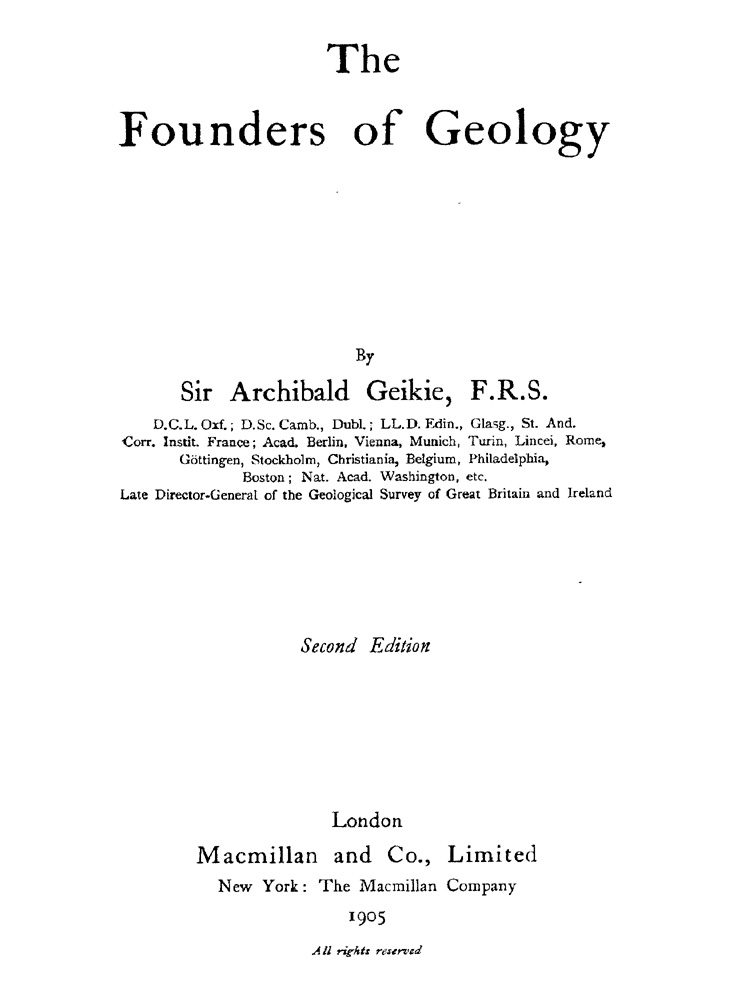GEIKIE, Archibald.
(1835 – 1924)
In the early part of this century, one of the most well known and respected geologists was Edinburgh-born Archibald Geikie, expert on the processes of erosion. In 1855, Geike was appointed to the Geological Survey of Great Britain under Murchison and ten years later was elected to the prestigious Royal Society, also becoming the first Director of the Scottish Geological Survey founded in 1867. Geikie's studies showed that rivers play a major role in soil erosion and established him as the foremost advocate of the fluvial theories of erosion. His best own works include: The Scenery of Scotland (1865), Life of Sir R. J. Murchison (1875, Test-Book of Geology (1882), The Founders of Geology (1897), The Ancient Volcanoes of Great Britain (1897) and Outlines of Field Geology (1876), most of which have remained in general use, having been reissued at various dates.
Biographical references: Barr, Index to Biographical Fragments, 1973: 96. • Cleevely, World Palæontological Collections, 1983: 126. • DNB. • DSB: 5, 333-8. • Encyclopaedia Britannica, 11th edition. • Lambrecht & Quenstedt, Catalogus, 1938: 156. • Poggendorff: 3, 501-2, 4, 486-7 & 5, 418. • Rasmussen, Geologiska Litteratur Færøerne, 1947. • Sarjeant, Geologists, 1980: 2, 1071-3, Suppl. 1 (1986), 1, 437, and Suppl. 2 (1995), 1, 646. • World Who's Who in Science: 640.
1. English, 1897 [First edition].
The | Founders Of Geology | By | Sir Archibald Geike, F.R.S. | [...3 lines of titles and memberships...] | London | Macmillian And Co., Limited | New York: The Macmillan Company | 1897 | All rights reserved.
8°: π5 B-T8 U6; 155l.; [i]-x, [1]-297, [3] p. Page size: 204 x 130 mm.
Contents: [i-ii], Half title page, "The Founders Of Geology," verso ornament.; [iii-iv], Title page, verso blank.; [v]-viii, "Preface."-dated 18 June 1897.; [ix]-x, "Contents."; [1]-289, Text.; [290], Blank.; [291]-297, "Index."; [1 pg], Blank.; [2 pgs], Publisher's list.
Very scarce. The text is divided into 6 lectures. 1. The Cosmogonists. 2. The Rise of Volcanic Geology. 3. History of the Doctrine of Geological Succession. 4. Rise of the Modern Conception of the Theory of the Earth. 5. The Rise of Stratigraphical Geology. 6. The Transition or Greywacke Formation resolved by Sedgwick and Murchison into the Cambrian, Sulirian and Devonian systems.
Bibliographical references: Roller & Goodman, Catalogue, 1976: 1, 449.

2. English, 1905 [2nd edition].
The | Founders of Geology. | By | Sir Archibald Geikie, F.R.S. | [...5 lines of titles and memberships...] | Second Edition | London | Macmillan and Co., Limited | New York: The Macmillan Company | 1905 | All rights reserved.
8°: [i]-xi, [1], [1]-486, [2] p., index. Page size: 224 x 142 mm.
Contents: [i-ii], Half title page, "The Founders of Geology," verso ornament.; [iii-iv], Title page, verso "First Edition (Extra Crown 8vo) 1897. | ..."; [v]-vii, "Preface."-dated 9 November 1905.; [viii], Blank.; [ix]-xi, "Contents."; [1 pg], Blank.; [1]-473, Text.; [474]-486, "Index."; [2 pgs], Publisher's list.
Scarce. One of the best histories of geology and accompanying sciences ever published in the English language. It recounts the story of the progress of geological ideas by reviewing the careers of some of the leaders by whom the progress was chiefly effected, giving full consideration to the lives and work of these major figures, and indicating in the process how geological ideas arose and were slowly worked out into the forms which they now wear. Some of the men whose careers and contributions are examined are Palissy, Guettard, Desmarest, Pallas, De Saussure, Arduino, Lehmann, Fuchsel, Werner, Hutton, Playfair, Sir James Hall, Giraud-Soulavie, Cuvier, Michell, Lyell, Logan, Darwin, Agassiz, Nicol, and others.
The author discusses such matters as geological ideas among the Greeks and Romans; growth of geological ideas in the Middle Ages; scientific cosmogonists- Descartes and Leibnitz; the rise of geology in France; the foundation of volcanic geology; the rise of geological travel; the history of the doctrine of geological succession; the Wernerian school of geology; the rise of the modern conception of the theory of the earth; the birth of experimental geology; the rise of stratigraphical geology and paleontology; early teachers and textbooks; the transition or Greywacke formation resolved into the Cambrian, Silurian and Devonian systems; the primordial fauna of Barrande; the pre-Cambrian rocks first begun to be set in order; the influence of Darwin; adoption of zonal stratigraphy of fossiliferous rocks; the rise of glacial geology; the development of geological map-making in Europe and North America; the rise of petrographical geology; and other related topics.
Bibliographical references: Roller & Goodman, Catalogue, 1976: 1, 449.
.